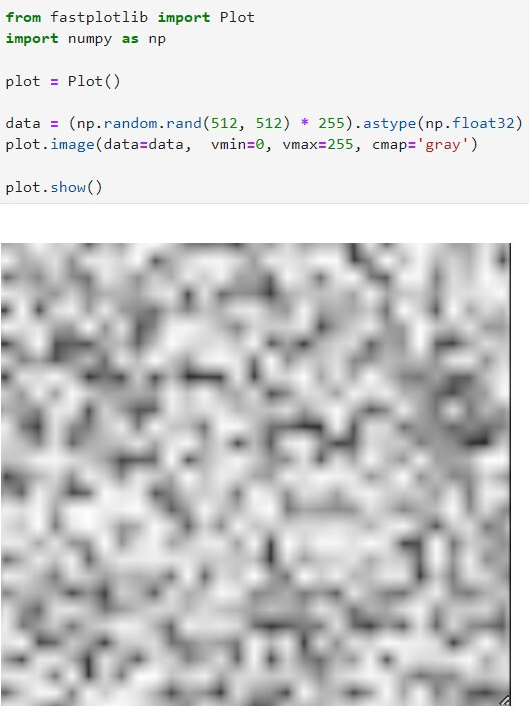Installation | GPU Drivers | Documentation | Examples | Contributing
Next-gen plotting library built using the pygfx rendering engine that can utilize Vulkan, DX12, or Metal via WGPU, so it is very fast! fastplotlib also aims to be an expressive plotting library that enables rapid prototyping for large scale explorative scientific visualization.
Note that the API is currently evolving quickly. We recommend using the latest notebooks from the repo but the general concepts are similar to those from the API shown in the video.
fastplotlib can run on anything that pygfx can also run, this includes:
✔️ Jupyter lab, using jupyter_rfb
✔️ PyQt and PySide
✔️ glfw
✔️ wxPython
Notes:
✔️ Non-blocking Qt/PySide output is supported in ipython and notebooks by using %gui qt. This must be called before importing fastplotlib!
:grey_exclamation: We do not officially support jupyter notebook through jupyter_rfb, this may change with notebook v7
😞 jupyter_rfb does not work in collab, see vispy/jupyter_rfb#77
Note
fastplotlibis currently in the alpha stage with breaking changes every ~month, but you're welcome to try it out or contribute! See our Roadmap. See this for a discussion on API stability: #121
http://fastplotlib.readthedocs.io/
The Quickstart guide is not interactive. We recommend cloning/downloading the repo and trying out the desktop or notebook examples: https://github.com/kushalkolar/fastplotlib/tree/main/examples
If someone wants to integrate pyodide with pygfx we would be able to have live interactive examples! 😃
Questions, issues, ideas? Post an issue or post on the discussion forum!
Install using pip.
pip install fastplotlibThis does not give you Qt or glfw, you will have to install one of them yourself depending on your preference.
pip install "fastplotlib[notebook]"Recommended: install simplejpeg for much faster notebook visualization, this requires you to first install libjpeg-turbo
pip install simplejpegNote
fastplotlibandpygfxare fast evolving projects, the version available through pip might be outdated, you will need to follow the "For developers" instructions below if you want the latest features. You can find the release history on pypi here: https://pypi.org/project/fastplotlib/#history
git clone https://github.com/fastplotlib/fastplotlib.git
cd fastplotlib
# install all extras in place
pip install -e ".[notebook,docs,tests]"Note
fastplotlibandpygfxare fast evolving, you may require the latestpygfxandfastplotlibfrom github to use the examples in the main branch.
Note that fastplotlib code is basically identical between desktop and notebook usage. The differences are:
- Running in
glfwrequires afastplotlib.run()call (which is really just awgpurun()call) - To use it in
Qtyou must encapsulate it within aQApplication, seeexamples/qt - Notebooks plots have ipywidget-based toolbars and widgets 😄
GLFW examples are here. GLFW is a "minimal" desktop framework.
https://github.com/fastplotlib/fastplotlib/tree/main/examples/desktop
Qt examples are here:
https://github.com/fastplotlib/fastplotlib/tree/main/examples/qt
Some of the examples require imageio:
pip install imageio
Notebook examples are here:
https://github.com/fastplotlib/fastplotlib/tree/main/examples/notebooks
Start with simple.ipynb.
Some of the examples require imageio:
pip install imageio
Our SciPy 2023 talk walks through numerous demos: https://github.com/fastplotlib/fastplotlib#scipy-talk
You will need a relatively modern GPU (newer integrated GPUs in CPUs are usually fine). Generally if your GPU is from 2017 or later it should be fine.
For more information see: https://wgpu-py.readthedocs.io/en/stable/start.html#platform-requirements
Vulkan drivers should be installed by default on Windows 11, but you will need to install your GPU manufacturer's driver package (Nvidia or AMD). If you have an integrated GPU within your CPU, you might still need to install a driver package too, check your CPU manufacturer's info.
You will generally need a linux distro that is from ~2020 or newer (ex. Ubuntu 18.04 won't work), this is due to the glibc requirements of the wgpu-native binary.
Debian based distros:
sudo apt install mesa-vulkan-drivers
# for better performance with the remote frame buffer install libjpeg-turbo
sudo apt install libjpeg-turboFor other distros install the appropriate vulkan driver package, and optionally the corresponding libjpeg-turbo package for better remote-frame-buffer performance in jupyter notebooks.
If you do not have a GPU you can perform limited software rendering using lavapipe. This should get you everything you need for that on Debian or Ubuntu based distros:
sudo apt install llvm-dev libturbojpeg* libgl1-mesa-dev libgl1-mesa-glx libglapi-mesa libglx-mesa0 mesa-common-dev mesa-vulkan-driversWGPU uses Metal instead of Vulkan on Mac. You will need at least Mac OSX 10.13. The OS should come with Metal pre-installed so you should be good to go!
We welcome contributions! See the contributing guide: https://github.com/kushalkolar/fastplotlib/blob/main/CONTRIBUTING.md
You can also take a look at our Roadmap for 2025 and Issues for ideas on how to contribute!




